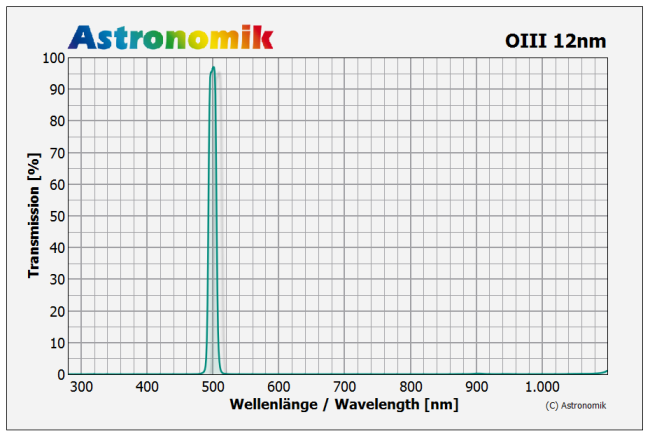About this product
Model: ak_oiii-ccd_6nm_125
Part Number: 10215625
The Astronomik OIII-CCD Filter is suitable for imaging of OIII nebulas from observation sites with light pollution and from dark sites as well. The contrast between an object glowing at 501nm and the background is increased enormous!
Due to the combination of the narrow bandwidth of 6nm and the high transmission of typically 96% the filter gives you an contrast boost, as all unwanted light from other wavelengths than 501nm is blocked form UV up to the IR. This results in an very dark background compared with any filters with a higher bandwidth
The FWHM of 6nm is matched to give you optimal performance with CCD and CMOS sensors with a very low dark current! The 6nm filter is the best choice if you are observing from a heavily light polluted site or if you are imaging faint objects in star-crowded regions of the milky-way.
Due to the new MFR coating technique you may use one single filter on all instruments up to f/4 without a significant reduction in performance.
FEATURES
- Guaranteed transmission of more than 90% of the OIII Line (501nm)
- Typical Transmission of 96% at the OIII Line (501 nm)
- Full-Width-Half Maximum (FWHM): 6nm
- Perfect blocking of unwanted light from UV up to the IR
- MFR Coating technique: Usable with all optics up to f/4
- Optically polished substrate, striae-free and free of residual stresses
- Not sensitive to high humidity or ageing effects
- Scratch-resistance!
- Excellent quality substrate, diffraction limited - the optical performance of your telescope will not be reduced
- Parfocal with other Astronomik filters
- 1mm Glass Thickness
- Supplied in a high-quality, long lasting, filter box
Imaging with Narrowband Filters
If you have to observe from light polluted sites (like most of us...), imaging with narrowband filters is the best way to take great images, as all kind of light pollution can be blocked very effective! Normally an H-alpha filter should be your first step into this amazing field of astrophotography! With an Narrowband H-alpha filter you will be able to take deep and contrasty images even with very heavy light pollution or with the full moon high up in the sky!
If you look at other astro-photos, an H-alpha is the best choice for all nebulas glowing red! An OIII filters expands your imaging possibilities, as you are able to image all greenish/blueish structures. Planetary nebulas and star forming regions are great targets! The SII filters completes your HSO-set of filters. With these three filters you are able to process your images like the ones from the Hubble space telescope!
Operation of the filter
The filter blocks all unwanted light from artifical light-pollution, natural airglow and moonlight. Especially light from High- and Low-Pressure Sodium and mercury lights and all lines of natural airglow are 100% blocked. The filter increases the contrast between the sky-background and objects glowing at the OIII line at 501nm.
Tips and Hints for more applications
Using the OIII filter together with H-alpha-CCD and SII-CCD filters you make produce false-color emission line images (HSO) in the same way as the Hubble-Space telescope. This is possible even from heavyly light polluted sites
Alternatives
The lower priced 12nm filters are the right choice for you, if you own a typical DSLR or a CCD camera with a high dark current! The 12nm filters should be the fist choice for cameras with an integrated guiding sensor, as you will have about twice as much stars compared to the 6nm filter.
Transmission Chart

- The horizontal axis is the Wavelength in Nanometers (nm). 400nm is deep blue, at 520nm the human eye senses green and at 600nm red. At 656nm is the famous "H-Alpha" emission line of hydrogen.
- The transmission in % is plotted on the vertical axis.
- The blue line shows the transmission of the filter.
- The most important emission lines from nebulas are shown in orange. The most important lines are from ionised Hydrogen (H-alpha and H-beta) and double ionised oxygen (OIII).
The major emission lines of artificial light pollution:
| Hg 435,8nm | Hg 546,1nm | Hg 577,0nm | Hg 578,1nm |
| Na 589,0nm | Na 589,6nm | Na 615,4nm | Na 616,1nm |
The major emission lines of nebulas:
H-β 486,1nm | OIII 495,9nm | OIII 500,7nm | H-α 656,3nm
Technical Data
- Guaranteed Transmission of more than 90% at the OIII Line (501 nm)
- Typical Transmission of 96% at the OIII Line (501 nm)
- Full-Width-Half Maximum (FWHM): 6nm
- Perfect blocking of unwanted light from UV up to the IR
- Parfocal with all Astronomik filters
- MFR Coating technique: Usable with all optics up to f/4
- Thickness of 1mm
- Not sensitive to moisture, scratch resistant or ageing
- Optically polished substrate, striae-free and free of residual stresses
- Astronomik filters are delivered in a high-quality, long lasting, filter box
Customer reviews
FAQ
Please fill in the form below to ask a question.